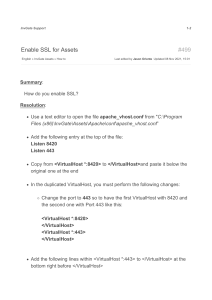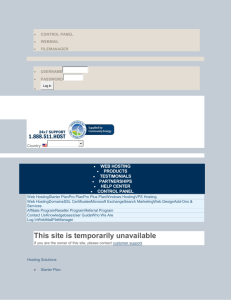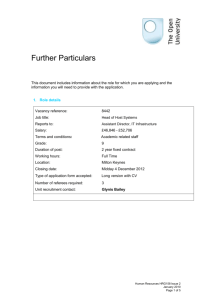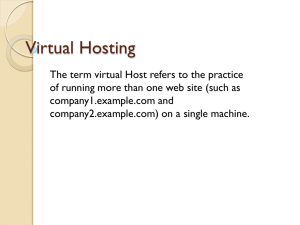Virtual Host (Web Server)
advertisement
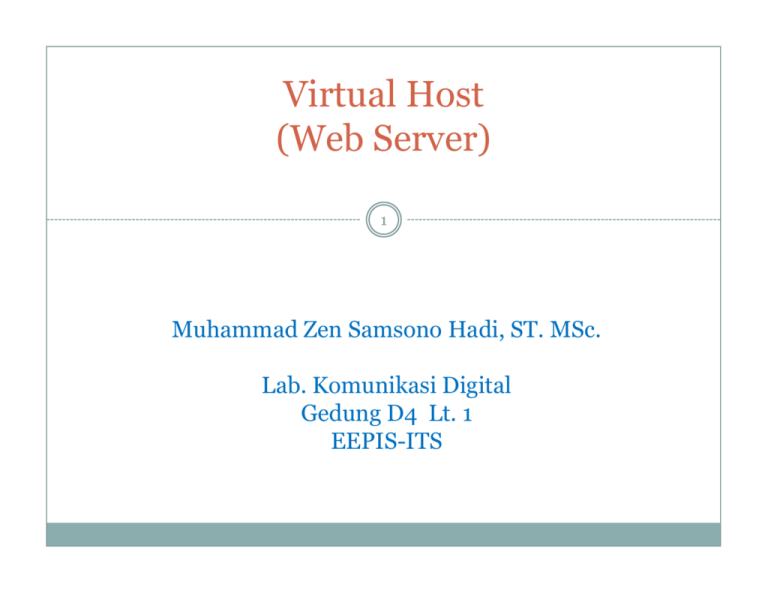
Virtual Host (Web Server) 1 Muhammad Zen Samsono Hadi, Hadi ST. ST MSc. MSc Lab. Komunikasi Digital G d Gedung D Lt. D4 Lt 1 EEPIS-ITS Virtual Networking implementation 2 Power consumption comparison 3 VS 5 Physical servers Virtual Server Power consumption comparison 230W x 5 x 24h = 27.6kwh 7 +a 230W x 24h = 5.5kwh + a 4 Virtual Server Advantages 5 Power saving g over multiple p p physical y servers Simplify system administration by integrating all servers into one physical machine Server hardware resource optimization Virtual Server disadvantages 6 When host server machine crash,, all virtual servers embedded in the server crash too. Virtual Hosting 7 General term used when y you run more than one website on a single system. Allows ISPs and hosting providers to make money by sharing resources among clients. Allows companies and individuals to save time and money - a single machine can host many websites. websites Virtual Host 8 Options for Hosting More than One Website on a Single System 9 Run separate instances of httpd servers: httpd –f /usr/local/apache/conf/httpd-virtual.conf Run a server that will listen on multiple ports and ser e different content depending on the port serve port. True Virtual Hosting - Allows multiple IP address and/or host names to be served through a single Apache server. IP-Based Name-Based Virtual Hosting: IP Based 10 You must configure your machine to “listen” listen for multiple IP addresses. One NIC binds to multiple p IP addresses One hostname is associated with each IP address www.yahoo.com 216.32.74.52 SERVER NIC sports.yahoo.com 216.115.105.243 Virtual Hosting: Name Based 11 A machine can host multiple p websites using g onlyy 1 IP address All hostnames have the same IP address Becoming more and more popular. SERVER some.mydomain.com 165.145.26.110 www.hisdomain.com NIC Setting-Up IP-Based Virtual Hosting: An Overview 12 Once you have secured the domain names/hostnames you want to use for your website, b it you need d tto assign i each h off th them a unique IP address. Some ISPs can assign you additional IP addresses. Blocks of IP addresses are usually assigned with b business T1s or DSL llines. Setting-Up IP-Based Virtual Hosting, Con’t. 13 You need to have DNS properly configured for your domains, e.g. The world needs to know that www.yourdomain.com is at the IP address 123.23.34.56. Remember, b your ISP can usually ll provide id DNS service for your domains. IP-Based Virtual Hosting: Setting Up Your Machine 14 Your web server needs to be configured to listen for the IP addresses related to your websites: UNIX-based OSs allow you to configure multiple IP addresses using sing the ifconfig command (m (must st be run as root) Usage: ifconfig interface:<sub interface:<sub-number> number> IP e.g: ifconfig eth0:0 165.230.30.71 ifconfig eth0:1 165.230.30.72 WinNT IP setup through Network control panel. Configuring Apache for IP-Based Virtual Hosting 15 Configuring Apache for Virtual Hosting is quite simple: Simply add a <VirtualHost> block within the httpd.conf file. Format: Format <VirtualHost IP-or-HOSTNAME:Port> #Any # y Valid httpd.conf p directives </VirtualHost> Required for each Virtual Host website your are using…therefore your httpd.conf can have multiple <VirtualHost> blocks. IP-Based VH Configuration con’t. 16 Typical <VirtualHost> block in httpd.conf: <VirtualHost www.bearsnest.org> DocumentRoot /home/www/bearsnest/htdocs ServerAdmin chrisjur@cju.com ServerName www.bearsnest.org www bearsnest org ErrorLog logs/bears-error_log TransferLog logs/bears-access_log Redirect /adprotech http://www.adprotech.com Alias /staff / / /home/chrisjur/htdocs/bn/staff / / / / </VirtualHost> The key: Vitual hosts will have their own unique DocumentRoot – different content for different sties. Steps for Setting-Up Name-Based Virtual Hosting 17 When setting up Name Name-based based virtual hosts, you need to add the special NameVirtualHost Directive to your httpd.conf: NameVirtualHost <Your IP Address> Which tells Apache the single IP address you will use for f all ll your websites. b i Now simply add <VirtualHost> blocks for each of your website b it d domains. i Name-Based VH Examples 18 NameVirtualHost NameVirt alHost 165.230.30.68 165 230 30 68 <VirtualHost www.yoursite.org> DocumentRoot /home/www/yoursite/htdocs ServerAdmin you@yoursite.com ServerName www.yoursite.com ErrorLog logs/yoursite-error_log </VirtualHost> <VirtualHost www.mysite.com> DocumentRoot /home/www/mysite/htdocs ServerAdmin me@mysite.com ServerName www.mysite.org ErrorLog logs/mysite-error_log </VirtualHost> Virtual Hosting Recap 19 Get y your DNS configured g for each domain IP-based Virtual Hosting vs. Name-based Virtual Hosting Configure your server for multiple IP addresses if using IP-based Virtual Hosting Create new directories for new Document Roots Add <VirtualHost> blocks to y your httpd.conf p Delivering Dynamic Content 20 Two ways y of delivering g dynamic y content for the Web: client-side or server-side technologies Client-Side Elements are downloaded to the browser and execute on the client’s system. Examples: E l J JavaScript, S i J Java Applets, A l client-side li id iimage maps. Web server administrator needs to see that MIME types are set correctly. Dynamic Content, con’t. 21 Ser Server-Side er Side Server processes “on-the-fly” content that is passed to client browser. Examples: server-side includes, CGI (Common Gateway Interface), server-side image maps, ASP (Active Server Pages), Java Servlets. PHP Server-side S id technologies h l i generally ll require i additional configuration of the Web server in order to function properly. Usually require specific Apache modules. modules Enabling server-side technologies generally has security implications.

